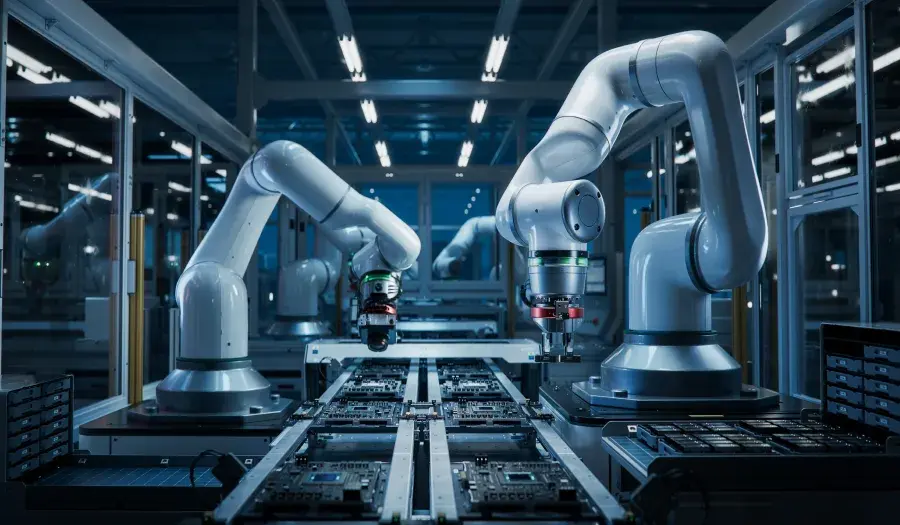In this article, we explore the most pressing challenges food and beverage companies face today — and examine how the right technology can help address them with confidence.
The food and beverage industry stands at a pivotal moment in 2025. Today, companies must navigate a far more complex landscape than in the past. Shifting global trade policies, increasing pressure for environmental responsibility, workforce shortages, evolving consumer expectations, and tightening regulations are reshaping how food and beverage businesses must operate to stay competitive and compliant. Even as the industry continues its digital evolution, these growing external pressures are forcing companies to rethink their strategies across the board — from procurement and production to compliance and customer engagement.
In this article, we explore the most pressing challenges food and beverage companies face today — and examine how the right technology can help address them with confidence.
The Industry Overview
As consumer needs continue to evolve, the global food and beverage industry is expanding concurrently to meet new demands. According to Credence Research, the global food and beverages market is expected to grow from $6.2 trillion in 2024 to $9.8 trillion by 2032, reflecting a compound annual growth rate (CAGR) of 5.9%.
Major players in the market include McDonald's Corporation, Nestlé S.A., Unilever PLC, Mondelez International Inc., DoorDash Inc., and Chipotle Mexican Grill Inc., as reported by Xtalks in their 2025 overview of the biggest market traders by market cap.
While traditional retail channels such as supermarkets and hypermarkets continue to dominate in terms of volume, the food and beverage E-commerce segment is also showing rapid growth. According to The Business Research Company, the global food and beverage E-commerce market is projected to grow from $379.9 billion in 2021 to $903.5 billion by 2026, achieving a CAGR of 18.9%.
Despite this momentum and growing digital success, many food and beverage manufacturers remain concerned about the future. Even as the industry embraces technological innovation, it still faces critical challenges that must be addressed to maintain growth and stability.
Current Food & Beverage Industry Challenges
Food & Beverage companies face many ongoing challenges that threaten their ability to sustain themselves in the competitive market. We’ve picked the seven most critical ones.
1. Rising raw material costs and the impact of tariffs
In 2025, the food and beverage industry is grappling with escalating raw material costs, significantly influenced by newly imposed tariffs. For instance, according to \recent BBC reports , the U.S. administration has announced a 10% tariff on imports from various countries, with higher rates for specific partners like China and the European Union. These tariffs are expected to increase the average U.S. tariff rate to 25%, surpassing historical highs and potentially leading to inflation and economic disruption. Industries such as seafood, wine, and restaurants have expressed concerns over rising costs due to these tariffs.
As a result, many businesses are exploring alternative suppliers, renegotiating contracts, or investing in more localized procurement networks to reduce dependency on affected markets. Moreover, digital procurement platforms and AI-driven cost modeling tools are gaining traction, helping businesses anticipate price fluctuations and make more informed purchasing decisions.
In this environment, resilient supply chains and data-driven decision-making are becoming essential to maintaining profitability and consumer trust.
2. Demand for sustainability and supply chain transparency
Consumers are increasingly prioritizing sustainability and ethical practices, compelling food and beverage companies to enhance supply chain transparency. Advanced traceability systems are becoming integral in reducing Scope 3 carbon emissions, which encompass indirect emissions within the supply chain. By implementing multi-enterprise platforms, companies can monitor emissions data from various sources, facilitating the tracking of supplier progress and ensuring corrective actions are taken.
Moreover, according to Food Logistics, surplus food contributes to approximately 4% of U.S. greenhouse gas emissions, equivalent to the emissions from 54 million cars. Addressing food waste through improved supply chain practices is essential for reducing the industry's environmental impact.
3. Inventory management challenges amid demand volatility
The industry faces significant challenges in inventory management due to supply chain disruptions and fluctuating demand. In 2025, these issues are particularly pronounced for midsize and smaller companies, which may have less leverage with larger suppliers. Strategic inventory optimization is crucial to protect capital and support growth.
Additionally, the food and beverage sector is experiencing increased supply chain disruptions, necessitating robust strategies to maintain inventory balance and effectively meet consumer demand.
4. Navigating evolving regulatory compliance
The regulatory landscape for the food and beverage industry is becoming increasingly complex. In 2025, companies must adapt to new regulations, including ingredient bans and updated labeling requirements. For example, according to DLA Piper's report on food and beverage news and trends, the FDA has announced a uniform compliance date of January 1, 2028, for final food labeling regulations issued between January 1, 2025, and December 31, 2026.
Staying abreast of these changes and implementing necessary adjustments is vital to avoid legal repercussions and maintain market access.
5. Labor shortages and the drive toward automation
Labor shortages continue to challenge the food and beverage industry. As of 2025, 70% of restaurant operators report having job openings that are difficult to fill, and 45% indicate they lack sufficient staff to meet existing customer demand.
To mitigate these challenges, companies are increasingly turning to automation. Implementing automated technologies in food processing and packaging can enhance productivity and efficiency to address labor gaps and reduce operational costs.
6. Pressure to reduce carbon emissions
The food and beverage industry is under mounting pressure to reduce its carbon footprint. Food production accounts for 10-30% of a household's carbon footprint, with production activities contributing 68% of these emissions.
Companies are adopting strategies, such as utilizing renewable energy sources, optimizing logistics, and implementing sustainable agricultural practices, to address these concerns. Advanced traceability systems also play a role in monitoring and managing emissions throughout the supply chain.
7. Managing brand reputation amid evolving consumer expectations
In an era of instant information and heightened consumer awareness, managing brand reputation is more critical than ever. Consumers demand transparency regarding product origins, ethical sourcing, and sustainability practices. Brands are leveraging technology to ensure ethical practices and enhance supply chain transparency to meet consumer expectations and build trust.
Additionally, companies are focusing on health-centric innovations and clean labeling to align with consumer preferences for healthier and more transparent food options.
How SAP Can Help Anticipate Food & Beverage Industry Trends
While these challenges may seem diverse in nature — from rising tariffs to shifting consumer values — they share one thing in common: they demand a smarter, more connected way of running a business. And this is exactly where SAP steps in. With a robust suite of integrated solutions, SAP empowers food and beverage companies to not only face these issues head-on, but to turn them into opportunities for long-term growth and resilience. Below are just some examples of solutions that perfectly address the challenges described above.
SAP S/4HANA to manage rising raw material costs and tariff impact
SAP S/4HANA equips companies with real-time visibility into procurement, supplier performance, and contract terms, enabling purchasing teams to react swiftly to changing cost structures. Through predictive analytics and scenario planning, businesses can simulate the financial effects of new tariffs and adjust sourcing strategies before disruptions hit the bottom line. This level of agility is especially critical in a sector where ingredient costs can shift overnight.
SAP Sustainability Control Tower and SAP Integrated Business Planning for supply chain transparency and sustainability
SAP Sustainability Control Tower helps businesses capture and track ESG performance indicators across their operations and supply networks. Combined with SAP Integrated Business Planning, companies gain end-to-end traceability — from farm to fork — enabling them to reduce waste, monitor Scope 3 emissions, and demonstrate compliance with sustainability targets. This not only helps meet regulatory obligations, but also positions companies to win over increasingly eco-conscious consumers and investors.
SAP Extended Warehouse Management for inventory optimization amid demand volatility
SAP Extended Warehouse Management (EWM) brings precision and flexibility to inventory operations by connecting real-time warehouse data with production and sales forecasts. This ensures optimal stock levels, reduces unnecessary storage costs, and allows companies to react quickly to demand spikes — without compromising service levels. For food companies working with perishable goods, this level of responsiveness can make all the difference.
SAP S/4HANA for Product Compliance to navigate regulatory changes
As regulatory requirements evolve, SAP solutions help ensure that businesses don’t just keep up — but stay ahead. SAP S/4HANA for Product Compliance enables manufacturers to manage and update regulatory data for ingredients, allergens, and product labeling in one centralized system. This allows teams to quickly respond to changes, like the upcoming FDA label compliance deadlines, without disrupting production schedules or risking non-compliance penalties.
SAP Manufacturing Execution System and SAP Intelligent RPA to address labor shortages
On the operations side, the labor shortage continues to pressure manufacturers and distributors. Here, automation becomes not just a luxury, but a necessity. SAP Manufacturing Execution System helps digitize and streamline production floor operations, reducing reliance on manual labor. Meanwhile, SAP Business Technology Platform and SAP Intelligent RPA enable the automation of administrative processes like supplier onboarding or invoice approvals, freeing up teams for higher-value tasks and maintaining operational continuity, even with leaner workforces.
SAP Product Footprint Management to reduce carbon emissions
The industry’s growing responsibility to reduce carbon emissions is also addressed directly through SAP’s Product Footprint Management solution. By calculating the carbon footprint of products throughout their lifecycle (across sourcing, production, packaging, and logistics) companies can pinpoint areas for improvement and make data-driven decisions to cut emissions. When sustainability goals are embedded directly into business systems, they become part of daily operations, not just annual reports.
SAP Customer Experience to manage brand reputation and meet consumer expectations
And finally, when it comes to managing brand reputation in a hyper-connected consumer world, SAP provides the digital backbone needed to listen, adapt, and respond. With SAP Customer Experience solutions, brands can gather real-time feedback from customers, analyze sentiment, and personalize their marketing based on what people actually want — not assumptions. This means proactively shaping expectations, not just keeping up with them.
In essence, SAP offers a framework for smarter decision-making, better visibility, and stronger connections across the entire value chain. By integrating operations, compliance, sustainability, and customer engagement into one intelligent system, food and beverage companies can transform today’s challenges into tomorrow’s competitive advantages.
Looking Ahead
When we examine trends in the food and beverage industry, it becomes clear that the rules of the game are changing rapidly. Success is no longer determined by product quality alone, but by how intelligently a company can operate: how fast it adapts, how transparently it runs, how responsibly it sources, and how closely it listens to its customers. These aren’t isolated priorities; they’re all deeply connected.
Technology has evolved to meet these challenges, but the real differentiator lies in how it’s applied. It’s not just about choosing SAP solutions — it’s about knowing how to shape them around real-world business processes, regulatory landscapes, and industry-specific needs. That’s where experience counts.
At LeverX, we bring deep expertise in both digital transformation and the food and beverage industry itself. From improving operational agility to supporting sustainability goals, we help companies turn complex requirements into clear, scalable strategies. Our approach is collaborative, practical, and built around long-term value — so our clients are not only prepared for 2025, but also for whatever comes after.
If your company is navigating the intersection of growth, innovation, and responsibility, we’re here to guide you forward. Contact our experts today to find out how SAP can help you.
How useful was this article?
Thanks for your feedback!


.jpg)
